|
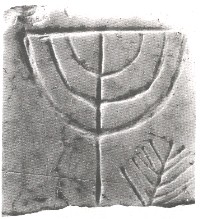 Jewish presence in Greece dates at least to the mention by Strabo in approximately
85 B.C.E. that Jews could be found in all the cities of the eastern Mediterranean (VII 7 4). There may well have
been Jews, if not Jewish communities, living in Greek cities as far back as the Babylonian Exile (586-530 B.C.E.).
After the wars of the Maccabees, between 170 and 161 B.C.E., many Hellenized Jews left Judaea and settled in the
new commercial centers, such as Alexandria and Antioch, of the Hellenistic world. From these communities smaller
groups moved to some of the coastal Aegean cities such as Ephesus, Smyrna, Thessaloniki, and, according to tradition,
Chalkis. Jewish communities also may have been founded on Crete at this time. In any case, by the time of the Apostle
Paul there were flourishing Jewish communities in most of the major Greek cities. Jewish presence in Greece dates at least to the mention by Strabo in approximately
85 B.C.E. that Jews could be found in all the cities of the eastern Mediterranean (VII 7 4). There may well have
been Jews, if not Jewish communities, living in Greek cities as far back as the Babylonian Exile (586-530 B.C.E.).
After the wars of the Maccabees, between 170 and 161 B.C.E., many Hellenized Jews left Judaea and settled in the
new commercial centers, such as Alexandria and Antioch, of the Hellenistic world. From these communities smaller
groups moved to some of the coastal Aegean cities such as Ephesus, Smyrna, Thessaloniki, and, according to tradition,
Chalkis. Jewish communities also may have been founded on Crete at this time. In any case, by the time of the Apostle
Paul there were flourishing Jewish communities in most of the major Greek cities.
|
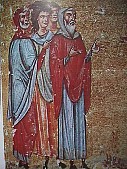 The scanty surviving evidence concerning the Jews of the late antique and Byzantine periods indicates that
the Jews in Greece lived more or less as did their Christian neighbors. The famous 12th century record of the Jews
of Greece compiled by Benjamin of Tudela during his travels through Greece indicates a uniform dispersion of Jewish
communities. The Jewish community of Thebes was so closely identified with the silk industry that Roger II of Sicily
(1095-1154) forcibly moved almost the entire community to Sicily to introduce the silk industry in his Norman kingdom.
In Crete, under Venetian rule after the fall of Constantinopole to the Fourth Crusade in 1204, Jews were producers
and exporters of agricultural goods. Kosher wines and cheeses from Crete were sent as faras the Baltic port of
Lubeck. The scanty surviving evidence concerning the Jews of the late antique and Byzantine periods indicates that
the Jews in Greece lived more or less as did their Christian neighbors. The famous 12th century record of the Jews
of Greece compiled by Benjamin of Tudela during his travels through Greece indicates a uniform dispersion of Jewish
communities. The Jewish community of Thebes was so closely identified with the silk industry that Roger II of Sicily
(1095-1154) forcibly moved almost the entire community to Sicily to introduce the silk industry in his Norman kingdom.
In Crete, under Venetian rule after the fall of Constantinopole to the Fourth Crusade in 1204, Jews were producers
and exporters of agricultural goods. Kosher wines and cheeses from Crete were sent as faras the Baltic port of
Lubeck. |
|
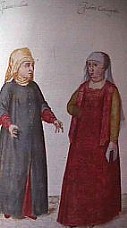 In general terms the Jews of Greece during this period can be described as “Romaniot” Jews, i.e. , Jews of
the empire of the “second Rome”, Byzantium. Their status under Byzantine rule was peculiar, but they were protected
by law and only rarely do contemporary sources convey the impression of persecution. Life was not made easy for
them, lest they forget their refusal to accept the Christian Messiah, but they were recognized at least as descendants
of the Chosen People. Integration into the cultural pattern of Greek life can be seen in the loss of Hebrew by
many communities. Some communities tried to maintain at least the form of Hebrew by writing out whole sections
of the Tanah in Greek using Hebrew script, as in the illuminated Book of Job from Crete (Ms. Gr. 135 Bib. Nationale).
Other communities must have been assimilated completely. In the Mani, in southern Greece, the inhabitants claim
to be descendants of “lost” Jews , claims now mixed with legends of the Ten Lost Tribes of Israel. Despite this
assimilation, on the eve of World War II there were still several communities of Romaniot Jews in Greece claiming
unbroken continuity back into antiquity. Kerkyra (Corfu), Zakynthos (Zante), Ioannina, Arta, Preveza, Patras, Chalkis,
and Volos still maintained traces of the old Romaniot minhag, or liturgy. In general terms the Jews of Greece during this period can be described as “Romaniot” Jews, i.e. , Jews of
the empire of the “second Rome”, Byzantium. Their status under Byzantine rule was peculiar, but they were protected
by law and only rarely do contemporary sources convey the impression of persecution. Life was not made easy for
them, lest they forget their refusal to accept the Christian Messiah, but they were recognized at least as descendants
of the Chosen People. Integration into the cultural pattern of Greek life can be seen in the loss of Hebrew by
many communities. Some communities tried to maintain at least the form of Hebrew by writing out whole sections
of the Tanah in Greek using Hebrew script, as in the illuminated Book of Job from Crete (Ms. Gr. 135 Bib. Nationale).
Other communities must have been assimilated completely. In the Mani, in southern Greece, the inhabitants claim
to be descendants of “lost” Jews , claims now mixed with legends of the Ten Lost Tribes of Israel. Despite this
assimilation, on the eve of World War II there were still several communities of Romaniot Jews in Greece claiming
unbroken continuity back into antiquity. Kerkyra (Corfu), Zakynthos (Zante), Ioannina, Arta, Preveza, Patras, Chalkis,
and Volos still maintained traces of the old Romaniot minhag, or liturgy.
|
|
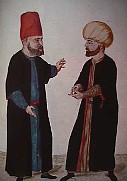 By the third quarter of the 15th century the Ottoman Empire had supplanted the Byzantine. Ottoman policy
toward minorities was based on Islamic law, which recognized both Jews and Christians as a separate millet (nation)
with religious and , to an extraordinary extent, legal autonomy within their own communities. This tolerant millet
system encouraged the immigration of Jews from Europe who had been feeling the brunt of Christian persecution,
notably, in the late 15th century, in Spain. This immigration was welcomed by the Ottomans because of the economic
stimulation it brought. In 1492 when Ferdinand and Isabella proclaimed the Edict of Expulsion for the Jews of Spain,
Sultan Bayezid II proclaimed that Jews from Spain would be welcome in the Ottoman Empire, and over 20,000 Sephardic
or Iberian Jews arrived in Thessaloniki the same year. Soon afterwards 36,000 Jews left Sicily, many of them to
settle in the Balkans. By the third quarter of the 15th century the Ottoman Empire had supplanted the Byzantine. Ottoman policy
toward minorities was based on Islamic law, which recognized both Jews and Christians as a separate millet (nation)
with religious and , to an extraordinary extent, legal autonomy within their own communities. This tolerant millet
system encouraged the immigration of Jews from Europe who had been feeling the brunt of Christian persecution,
notably, in the late 15th century, in Spain. This immigration was welcomed by the Ottomans because of the economic
stimulation it brought. In 1492 when Ferdinand and Isabella proclaimed the Edict of Expulsion for the Jews of Spain,
Sultan Bayezid II proclaimed that Jews from Spain would be welcome in the Ottoman Empire, and over 20,000 Sephardic
or Iberian Jews arrived in Thessaloniki the same year. Soon afterwards 36,000 Jews left Sicily, many of them to
settle in the Balkans.
|
|
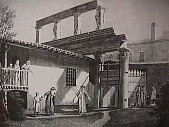 Within a generation a Judaeo-Spanish culture had been transplanted to many centers in the Ottoman Empire.
This was not always done smoothly. Many of the Sepharadim were Marranos, Jews who had converted to Christianity
in the 14th century, thereby being able to participate in much of Europe’s cultural and intellectual life. Their
reconversion to Judaism was sometimes difficult, and their pride and sense of cultural superiority caused friction
in their dealings with Romaniot Jews. Whatever the difficulties, the former Romaniot communities of Constantinople,
Edirne (Adrianople), Thessaloniki, and Rhodes were forced by the weight of numbers and cultural superiority to
adopt not only the minhag but also the language of the newcomers. A new, and certainly one of the most exciting
periods of Balkan Jewry began. In 1497 the first book printed in Constantinople was published in Hebrew, well over
two hundred years before the first Greek books were printed in the Balkans. Some Jews, notably Joseph Nasi (1520?-1579)
during the reigns of Suleiman the Magnificent and Selim II, rose to high positions in the Ottoman service. Within a generation a Judaeo-Spanish culture had been transplanted to many centers in the Ottoman Empire.
This was not always done smoothly. Many of the Sepharadim were Marranos, Jews who had converted to Christianity
in the 14th century, thereby being able to participate in much of Europe’s cultural and intellectual life. Their
reconversion to Judaism was sometimes difficult, and their pride and sense of cultural superiority caused friction
in their dealings with Romaniot Jews. Whatever the difficulties, the former Romaniot communities of Constantinople,
Edirne (Adrianople), Thessaloniki, and Rhodes were forced by the weight of numbers and cultural superiority to
adopt not only the minhag but also the language of the newcomers. A new, and certainly one of the most exciting
periods of Balkan Jewry began. In 1497 the first book printed in Constantinople was published in Hebrew, well over
two hundred years before the first Greek books were printed in the Balkans. Some Jews, notably Joseph Nasi (1520?-1579)
during the reigns of Suleiman the Magnificent and Selim II, rose to high positions in the Ottoman service.
|
|
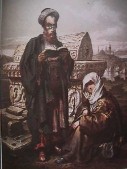 The Greek War of Independence brought disaster to the Jewish communities in the Peloponnesos, where the revolution
erupted in 1821. The Jews, because of their close associate with the Ottoman administration, were massacred along
with the Turks. The Jewish communities of Mistras, Tripolis, and Kalamata were decimated; the few survivors moved
north to settle in Chalkis and Volos, still under Ottoman rule. Patras lost its ancient Jewish community, which
was refounded only in 1905. By the late 19th century much of the energy of the Greek state was being spent in attempts to regain those
southern Balkan territories historically associated with Greek history and language. National “Hellenic” consciousness
became the ideal, and Jews, along with the other non – “Hellenic” peoples of the country, found themselves in the
process of Hellenization. This was not much of a problem to the Jews of southern or northwestern Greece, for as
Romanios they already were Hellenized to a great extent in both language and custom. For the Sepharadim in northeastern
Greece, however, who came under the Greek rule after the Balkan Wars of 1912/3, there was a problem. The Greek War of Independence brought disaster to the Jewish communities in the Peloponnesos, where the revolution
erupted in 1821. The Jews, because of their close associate with the Ottoman administration, were massacred along
with the Turks. The Jewish communities of Mistras, Tripolis, and Kalamata were decimated; the few survivors moved
north to settle in Chalkis and Volos, still under Ottoman rule. Patras lost its ancient Jewish community, which
was refounded only in 1905. By the late 19th century much of the energy of the Greek state was being spent in attempts to regain those
southern Balkan territories historically associated with Greek history and language. National “Hellenic” consciousness
became the ideal, and Jews, along with the other non – “Hellenic” peoples of the country, found themselves in the
process of Hellenization. This was not much of a problem to the Jews of southern or northwestern Greece, for as
Romanios they already were Hellenized to a great extent in both language and custom. For the Sepharadim in northeastern
Greece, however, who came under the Greek rule after the Balkan Wars of 1912/3, there was a problem.
|
|
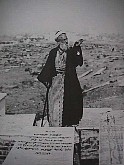 Thessaloniki was a bizarre city even by Balkan standards. At the turn of the century its population was approximately
one-third Greek and more than one-half Jewish, with the balance made up of Turks, Bulgars, and other nationalities.
The language of government and law was Osmanli, but the general commercial life of the city was conducted in the
language of the Sepharadim, Ladino, the Spanish of Cervantes with heavy accretions of Turkish, Arabic, Greek, and
Bulgarian. The city’s horizon was spiked with minarets and in its center lay a sprawling Jewish cemetery that reached
up to the walls of the old city. On Friday afternoons almost all of the city’s commercial life ceased for most
of the stevedores and porters were Jews. Over 32 synagogues, with names like Aragon, Castille, Toledo, and Magrebi,
reminiscent of a time long past in a land abandoned in desperation and sadness, provided religious centers for
the Sepharadim. The population included Karaites as well as Donmeh, followers of the 17th century pseudo-Messiah
Sabbatai Zevi. Hellenization sought to absorb this incredibly medieval city into contemporary Greek life. Thessaloniki was a bizarre city even by Balkan standards. At the turn of the century its population was approximately
one-third Greek and more than one-half Jewish, with the balance made up of Turks, Bulgars, and other nationalities.
The language of government and law was Osmanli, but the general commercial life of the city was conducted in the
language of the Sepharadim, Ladino, the Spanish of Cervantes with heavy accretions of Turkish, Arabic, Greek, and
Bulgarian. The city’s horizon was spiked with minarets and in its center lay a sprawling Jewish cemetery that reached
up to the walls of the old city. On Friday afternoons almost all of the city’s commercial life ceased for most
of the stevedores and porters were Jews. Over 32 synagogues, with names like Aragon, Castille, Toledo, and Magrebi,
reminiscent of a time long past in a land abandoned in desperation and sadness, provided religious centers for
the Sepharadim. The population included Karaites as well as Donmeh, followers of the 17th century pseudo-Messiah
Sabbatai Zevi. Hellenization sought to absorb this incredibly medieval city into contemporary Greek life.
|
|
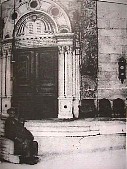 For the Sepharadim, their Spanish culture was a means of preserving their Jewish identity when religious
observance began to slip. If a Sephardic Jew were to lose his religious commitment to Judaism, he had a strong
secular Judaeo-Spanish culture to fall back on. By the late 1930’s, however, several factors had disrupted much
of this culture. Hellenization required the official imposition of the Greek language; of the establishment of
Sunday, not Saturday as the day of rest; and the considerable re-organization of the traditional religious life
of the Jews according to the laws of the Greek state. In August 1917, fire swept through the Jewish quarter, causing
great loss of life and property, from which it did not recover. Confiscations, which continued until the late 1930’s,
began of of vast sections of the ancient cemetery. In the 1920’s the enormous influx of Greek refugees from Asia
Minor resulting from the exchange of populations between Greece and Turkey fundamentally altered the city’s ethnic
structure. National and economic life increasingly came to be centered in Athens, and many Jews from Thessaloniki
moved south to the capital. As these factors weakened the Thessaloniki Jewish community, more and more of its members
left Greece altogether, for Palestine, Europe, South Africa, and the United States. By 1939 the Thessaloniki Jewish
community had fallen from approximately 90,000 at the turn of the century to 56,000. For the Sepharadim, their Spanish culture was a means of preserving their Jewish identity when religious
observance began to slip. If a Sephardic Jew were to lose his religious commitment to Judaism, he had a strong
secular Judaeo-Spanish culture to fall back on. By the late 1930’s, however, several factors had disrupted much
of this culture. Hellenization required the official imposition of the Greek language; of the establishment of
Sunday, not Saturday as the day of rest; and the considerable re-organization of the traditional religious life
of the Jews according to the laws of the Greek state. In August 1917, fire swept through the Jewish quarter, causing
great loss of life and property, from which it did not recover. Confiscations, which continued until the late 1930’s,
began of of vast sections of the ancient cemetery. In the 1920’s the enormous influx of Greek refugees from Asia
Minor resulting from the exchange of populations between Greece and Turkey fundamentally altered the city’s ethnic
structure. National and economic life increasingly came to be centered in Athens, and many Jews from Thessaloniki
moved south to the capital. As these factors weakened the Thessaloniki Jewish community, more and more of its members
left Greece altogether, for Palestine, Europe, South Africa, and the United States. By 1939 the Thessaloniki Jewish
community had fallen from approximately 90,000 at the turn of the century to 56,000.
|
|
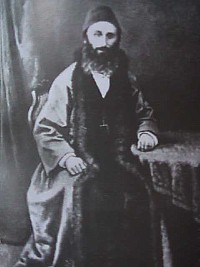 If the Thessaloniki Jewish community was unique in its identification with its Spanish past, the Athens Jewish
community was equally unique for its heterogeneity. Throughout the Middle Ages and into the 17th century when Sabbatai
Zevi visited the city there are periodic references to a Jewish presence in Athens. The absence of Jews in Athens
immediately following the Greek War of Independence is ominous, indicating that they either fled or were massacred
as were the Turks. We hear of the first ‘new’ Jews in the city when the Bavarian King Otto I of Greece settled
in Athens in 1834, for with him came a man named Max Rothschild, perhaps the first Jew to arrive in the new capital.
He was soon followed by a number of other Jews, most of them Bavarian and therefore Ashkenazi in background. Within
a short period of time Jews from Turkey, many of them from Smyrna if one can judge by family names, began to settle
in the city. By the middle of the 19th century a small Jewish community, but one with no determining tradition,
had been established in Athens. If the Thessaloniki Jewish community was unique in its identification with its Spanish past, the Athens Jewish
community was equally unique for its heterogeneity. Throughout the Middle Ages and into the 17th century when Sabbatai
Zevi visited the city there are periodic references to a Jewish presence in Athens. The absence of Jews in Athens
immediately following the Greek War of Independence is ominous, indicating that they either fled or were massacred
as were the Turks. We hear of the first ‘new’ Jews in the city when the Bavarian King Otto I of Greece settled
in Athens in 1834, for with him came a man named Max Rothschild, perhaps the first Jew to arrive in the new capital.
He was soon followed by a number of other Jews, most of them Bavarian and therefore Ashkenazi in background. Within
a short period of time Jews from Turkey, many of them from Smyrna if one can judge by family names, began to settle
in the city. By the middle of the 19th century a small Jewish community, but one with no determining tradition,
had been established in Athens.
|
|
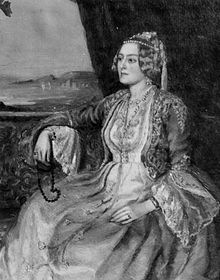 For a time this community was the object of attention for the Duchess of Plaisance, Sophie Berbe Marboise.
A highly eccentric French-American lady who had married the Duke of Plaisance, a member of the Napoleonic aristocracy,
Sophie fancied herself an adherent of what she called ‘the faith of Moses.’ She dressed heavily in veils, ate no
pork, befriended Jews, and would seem to have lived in her own world of fancy and romance. On her death in 1854
Sophie left much of the considerable property she had bought in Athens to the Athens Jewish community, which at
that time had no official charter of incorporation. The land she donated stretched from the Zappeion southwest
around the acropolis and north to Omonia Square. The Jews of Athens never claimed their gift. Even if the community’s
legal position had been defined, the time was not such for it to press claims in Athens. For a time this community was the object of attention for the Duchess of Plaisance, Sophie Berbe Marboise.
A highly eccentric French-American lady who had married the Duke of Plaisance, a member of the Napoleonic aristocracy,
Sophie fancied herself an adherent of what she called ‘the faith of Moses.’ She dressed heavily in veils, ate no
pork, befriended Jews, and would seem to have lived in her own world of fancy and romance. On her death in 1854
Sophie left much of the considerable property she had bought in Athens to the Athens Jewish community, which at
that time had no official charter of incorporation. The land she donated stretched from the Zappeion southwest
around the acropolis and north to Omonia Square. The Jews of Athens never claimed their gift. Even if the community’s
legal position had been defined, the time was not such for it to press claims in Athens.
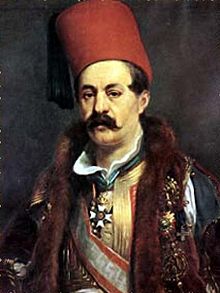 During the 1840’s a regular part of the Easter celebrations in Athens included the ritual burning of a ‘Judas’
in effigy. In 1847 Max Rothschild persuaded the Greek prime minister, John Kolettis, to stop this practice. Lacking
a Judas, public feeling focussed on a Jew of questionable business integrity named Don Pacifico, who had been born
on Gibraltar and was therefore a British citizen. Rioters sacked Don Pacifico’s house and burned his warehouse.
Don Pacifico’s exorbitant claims for restitution were supported by the British prime minister, Viscount Palmerston,
who sent the British fleet to blockade Piraeus. Whatever the justification for Don Pacifico’s unsavory reputation,
the strength of public feeling against him does not suggest a secure position for the Jewish community in Athens
at the time. During the 1840’s a regular part of the Easter celebrations in Athens included the ritual burning of a ‘Judas’
in effigy. In 1847 Max Rothschild persuaded the Greek prime minister, John Kolettis, to stop this practice. Lacking
a Judas, public feeling focussed on a Jew of questionable business integrity named Don Pacifico, who had been born
on Gibraltar and was therefore a British citizen. Rioters sacked Don Pacifico’s house and burned his warehouse.
Don Pacifico’s exorbitant claims for restitution were supported by the British prime minister, Viscount Palmerston,
who sent the British fleet to blockade Piraeus. Whatever the justification for Don Pacifico’s unsavory reputation,
the strength of public feeling against him does not suggest a secure position for the Jewish community in Athens
at the time.
Secure or not, the community was well established by the late 19th century. It was legally organized in 1885
and its official charter was granted in 1889. A synagogue was built in 1904 and dedicated in 1906 as Etz Hayyim
(indicating a strong Romaniot element). Heterogeneous as it was, the Athens Jewish community had several advantages
in its favor against the coming Nazi storm.
|
|

 The scanty surviving evidence concerning the Jews of the late antique and Byzantine periods indicates that
the Jews in Greece lived more or less as did their Christian neighbors. The famous 12th century record of the Jews
of Greece compiled by Benjamin of Tudela during his travels through Greece indicates a uniform dispersion of Jewish
communities. The Jewish community of Thebes was so closely identified with the silk industry that Roger II of Sicily
(1095-1154) forcibly moved almost the entire community to Sicily to introduce the silk industry in his Norman kingdom.
In Crete, under Venetian rule after the fall of Constantinopole to the Fourth Crusade in 1204, Jews were producers
and exporters of agricultural goods. Kosher wines and cheeses from Crete were sent as faras the Baltic port of
Lubeck.
The scanty surviving evidence concerning the Jews of the late antique and Byzantine periods indicates that
the Jews in Greece lived more or less as did their Christian neighbors. The famous 12th century record of the Jews
of Greece compiled by Benjamin of Tudela during his travels through Greece indicates a uniform dispersion of Jewish
communities. The Jewish community of Thebes was so closely identified with the silk industry that Roger II of Sicily
(1095-1154) forcibly moved almost the entire community to Sicily to introduce the silk industry in his Norman kingdom.
In Crete, under Venetian rule after the fall of Constantinopole to the Fourth Crusade in 1204, Jews were producers
and exporters of agricultural goods. Kosher wines and cheeses from Crete were sent as faras the Baltic port of
Lubeck.  Jewish presence in Greece dates at least to the mention by Strabo in approximately
85 B.C.E. that Jews could be found in all the cities of the eastern Mediterranean (VII 7 4). There may well have
been Jews, if not Jewish communities, living in Greek cities as far back as the Babylonian Exile (586-530 B.C.E.).
After the wars of the Maccabees, between 170 and 161 B.C.E., many Hellenized Jews left Judaea and settled in the
new commercial centers, such as Alexandria and Antioch, of the Hellenistic world. From these communities smaller
groups moved to some of the coastal Aegean cities such as Ephesus, Smyrna, Thessaloniki, and, according to tradition,
Chalkis. Jewish communities also may have been founded on Crete at this time. In any case, by the time of the Apostle
Paul there were flourishing Jewish communities in most of the major Greek cities.
Jewish presence in Greece dates at least to the mention by Strabo in approximately
85 B.C.E. that Jews could be found in all the cities of the eastern Mediterranean (VII 7 4). There may well have
been Jews, if not Jewish communities, living in Greek cities as far back as the Babylonian Exile (586-530 B.C.E.).
After the wars of the Maccabees, between 170 and 161 B.C.E., many Hellenized Jews left Judaea and settled in the
new commercial centers, such as Alexandria and Antioch, of the Hellenistic world. From these communities smaller
groups moved to some of the coastal Aegean cities such as Ephesus, Smyrna, Thessaloniki, and, according to tradition,
Chalkis. Jewish communities also may have been founded on Crete at this time. In any case, by the time of the Apostle
Paul there were flourishing Jewish communities in most of the major Greek cities. In general terms the Jews of Greece during this period can be described as “Romaniot” Jews, i.e. , Jews of
the empire of the “second Rome”, Byzantium. Their status under Byzantine rule was peculiar, but they were protected
by law and only rarely do contemporary sources convey the impression of persecution. Life was not made easy for
them, lest they forget their refusal to accept the Christian Messiah, but they were recognized at least as descendants
of the Chosen People. Integration into the cultural pattern of Greek life can be seen in the loss of Hebrew by
many communities. Some communities tried to maintain at least the form of Hebrew by writing out whole sections
of the Tanah in Greek using Hebrew script, as in the illuminated Book of Job from Crete (Ms. Gr. 135 Bib. Nationale).
Other communities must have been assimilated completely. In the Mani, in southern Greece, the inhabitants claim
to be descendants of “lost” Jews , claims now mixed with legends of the Ten Lost Tribes of Israel. Despite this
assimilation, on the eve of World War II there were still several communities of Romaniot Jews in Greece claiming
unbroken continuity back into antiquity. Kerkyra (Corfu), Zakynthos (Zante), Ioannina, Arta, Preveza, Patras, Chalkis,
and Volos still maintained traces of the old Romaniot minhag, or liturgy.
In general terms the Jews of Greece during this period can be described as “Romaniot” Jews, i.e. , Jews of
the empire of the “second Rome”, Byzantium. Their status under Byzantine rule was peculiar, but they were protected
by law and only rarely do contemporary sources convey the impression of persecution. Life was not made easy for
them, lest they forget their refusal to accept the Christian Messiah, but they were recognized at least as descendants
of the Chosen People. Integration into the cultural pattern of Greek life can be seen in the loss of Hebrew by
many communities. Some communities tried to maintain at least the form of Hebrew by writing out whole sections
of the Tanah in Greek using Hebrew script, as in the illuminated Book of Job from Crete (Ms. Gr. 135 Bib. Nationale).
Other communities must have been assimilated completely. In the Mani, in southern Greece, the inhabitants claim
to be descendants of “lost” Jews , claims now mixed with legends of the Ten Lost Tribes of Israel. Despite this
assimilation, on the eve of World War II there were still several communities of Romaniot Jews in Greece claiming
unbroken continuity back into antiquity. Kerkyra (Corfu), Zakynthos (Zante), Ioannina, Arta, Preveza, Patras, Chalkis,
and Volos still maintained traces of the old Romaniot minhag, or liturgy.  By the third quarter of the 15th century the Ottoman Empire had supplanted the Byzantine. Ottoman policy
toward minorities was based on Islamic law, which recognized both Jews and Christians as a separate millet (nation)
with religious and , to an extraordinary extent, legal autonomy within their own communities. This tolerant millet
system encouraged the immigration of Jews from Europe who had been feeling the brunt of Christian persecution,
notably, in the late 15th century, in Spain. This immigration was welcomed by the Ottomans because of the economic
stimulation it brought. In 1492 when Ferdinand and Isabella proclaimed the Edict of Expulsion for the Jews of Spain,
Sultan Bayezid II proclaimed that Jews from Spain would be welcome in the Ottoman Empire, and over 20,000 Sephardic
or Iberian Jews arrived in Thessaloniki the same year. Soon afterwards 36,000 Jews left Sicily, many of them to
settle in the Balkans.
By the third quarter of the 15th century the Ottoman Empire had supplanted the Byzantine. Ottoman policy
toward minorities was based on Islamic law, which recognized both Jews and Christians as a separate millet (nation)
with religious and , to an extraordinary extent, legal autonomy within their own communities. This tolerant millet
system encouraged the immigration of Jews from Europe who had been feeling the brunt of Christian persecution,
notably, in the late 15th century, in Spain. This immigration was welcomed by the Ottomans because of the economic
stimulation it brought. In 1492 when Ferdinand and Isabella proclaimed the Edict of Expulsion for the Jews of Spain,
Sultan Bayezid II proclaimed that Jews from Spain would be welcome in the Ottoman Empire, and over 20,000 Sephardic
or Iberian Jews arrived in Thessaloniki the same year. Soon afterwards 36,000 Jews left Sicily, many of them to
settle in the Balkans.  Within a generation a Judaeo-Spanish culture had been transplanted to many centers in the Ottoman Empire.
This was not always done smoothly. Many of the Sepharadim were Marranos, Jews who had converted to Christianity
in the 14th century, thereby being able to participate in much of Europe’s cultural and intellectual life. Their
reconversion to Judaism was sometimes difficult, and their pride and sense of cultural superiority caused friction
in their dealings with Romaniot Jews. Whatever the difficulties, the former Romaniot communities of Constantinople,
Edirne (Adrianople), Thessaloniki, and Rhodes were forced by the weight of numbers and cultural superiority to
adopt not only the minhag but also the language of the newcomers. A new, and certainly one of the most exciting
periods of Balkan Jewry began. In 1497 the first book printed in Constantinople was published in Hebrew, well over
two hundred years before the first Greek books were printed in the Balkans. Some Jews, notably Joseph Nasi (1520?-1579)
during the reigns of Suleiman the Magnificent and Selim II, rose to high positions in the Ottoman service.
Within a generation a Judaeo-Spanish culture had been transplanted to many centers in the Ottoman Empire.
This was not always done smoothly. Many of the Sepharadim were Marranos, Jews who had converted to Christianity
in the 14th century, thereby being able to participate in much of Europe’s cultural and intellectual life. Their
reconversion to Judaism was sometimes difficult, and their pride and sense of cultural superiority caused friction
in their dealings with Romaniot Jews. Whatever the difficulties, the former Romaniot communities of Constantinople,
Edirne (Adrianople), Thessaloniki, and Rhodes were forced by the weight of numbers and cultural superiority to
adopt not only the minhag but also the language of the newcomers. A new, and certainly one of the most exciting
periods of Balkan Jewry began. In 1497 the first book printed in Constantinople was published in Hebrew, well over
two hundred years before the first Greek books were printed in the Balkans. Some Jews, notably Joseph Nasi (1520?-1579)
during the reigns of Suleiman the Magnificent and Selim II, rose to high positions in the Ottoman service.  The Greek War of Independence brought disaster to the Jewish communities in the Peloponnesos, where the revolution
erupted in 1821. The Jews, because of their close associate with the Ottoman administration, were massacred along
with the Turks. The Jewish communities of Mistras, Tripolis, and Kalamata were decimated; the few survivors moved
north to settle in Chalkis and Volos, still under Ottoman rule. Patras lost its ancient Jewish community, which
was refounded only in 1905. By the late 19th century much of the energy of the Greek state was being spent in attempts to regain those
southern Balkan territories historically associated with Greek history and language. National “Hellenic” consciousness
became the ideal, and Jews, along with the other non – “Hellenic” peoples of the country, found themselves in the
process of Hellenization. This was not much of a problem to the Jews of southern or northwestern Greece, for as
Romanios they already were Hellenized to a great extent in both language and custom. For the Sepharadim in northeastern
Greece, however, who came under the Greek rule after the Balkan Wars of 1912/3, there was a problem.
The Greek War of Independence brought disaster to the Jewish communities in the Peloponnesos, where the revolution
erupted in 1821. The Jews, because of their close associate with the Ottoman administration, were massacred along
with the Turks. The Jewish communities of Mistras, Tripolis, and Kalamata were decimated; the few survivors moved
north to settle in Chalkis and Volos, still under Ottoman rule. Patras lost its ancient Jewish community, which
was refounded only in 1905. By the late 19th century much of the energy of the Greek state was being spent in attempts to regain those
southern Balkan territories historically associated with Greek history and language. National “Hellenic” consciousness
became the ideal, and Jews, along with the other non – “Hellenic” peoples of the country, found themselves in the
process of Hellenization. This was not much of a problem to the Jews of southern or northwestern Greece, for as
Romanios they already were Hellenized to a great extent in both language and custom. For the Sepharadim in northeastern
Greece, however, who came under the Greek rule after the Balkan Wars of 1912/3, there was a problem.  Thessaloniki was a bizarre city even by Balkan standards. At the turn of the century its population was approximately
one-third Greek and more than one-half Jewish, with the balance made up of Turks, Bulgars, and other nationalities.
The language of government and law was Osmanli, but the general commercial life of the city was conducted in the
language of the Sepharadim, Ladino, the Spanish of Cervantes with heavy accretions of Turkish, Arabic, Greek, and
Bulgarian. The city’s horizon was spiked with minarets and in its center lay a sprawling Jewish cemetery that reached
up to the walls of the old city. On Friday afternoons almost all of the city’s commercial life ceased for most
of the stevedores and porters were Jews. Over 32 synagogues, with names like Aragon, Castille, Toledo, and Magrebi,
reminiscent of a time long past in a land abandoned in desperation and sadness, provided religious centers for
the Sepharadim. The population included Karaites as well as Donmeh, followers of the 17th century pseudo-Messiah
Sabbatai Zevi. Hellenization sought to absorb this incredibly medieval city into contemporary Greek life.
Thessaloniki was a bizarre city even by Balkan standards. At the turn of the century its population was approximately
one-third Greek and more than one-half Jewish, with the balance made up of Turks, Bulgars, and other nationalities.
The language of government and law was Osmanli, but the general commercial life of the city was conducted in the
language of the Sepharadim, Ladino, the Spanish of Cervantes with heavy accretions of Turkish, Arabic, Greek, and
Bulgarian. The city’s horizon was spiked with minarets and in its center lay a sprawling Jewish cemetery that reached
up to the walls of the old city. On Friday afternoons almost all of the city’s commercial life ceased for most
of the stevedores and porters were Jews. Over 32 synagogues, with names like Aragon, Castille, Toledo, and Magrebi,
reminiscent of a time long past in a land abandoned in desperation and sadness, provided religious centers for
the Sepharadim. The population included Karaites as well as Donmeh, followers of the 17th century pseudo-Messiah
Sabbatai Zevi. Hellenization sought to absorb this incredibly medieval city into contemporary Greek life.  For the Sepharadim, their Spanish culture was a means of preserving their Jewish identity when religious
observance began to slip. If a Sephardic Jew were to lose his religious commitment to Judaism, he had a strong
secular Judaeo-Spanish culture to fall back on. By the late 1930’s, however, several factors had disrupted much
of this culture. Hellenization required the official imposition of the Greek language; of the establishment of
Sunday, not Saturday as the day of rest; and the considerable re-organization of the traditional religious life
of the Jews according to the laws of the Greek state. In August 1917, fire swept through the Jewish quarter, causing
great loss of life and property, from which it did not recover. Confiscations, which continued until the late 1930’s,
began of of vast sections of the ancient cemetery. In the 1920’s the enormous influx of Greek refugees from Asia
Minor resulting from the exchange of populations between Greece and Turkey fundamentally altered the city’s ethnic
structure. National and economic life increasingly came to be centered in Athens, and many Jews from Thessaloniki
moved south to the capital. As these factors weakened the Thessaloniki Jewish community, more and more of its members
left Greece altogether, for Palestine, Europe, South Africa, and the United States. By 1939 the Thessaloniki Jewish
community had fallen from approximately 90,000 at the turn of the century to 56,000.
For the Sepharadim, their Spanish culture was a means of preserving their Jewish identity when religious
observance began to slip. If a Sephardic Jew were to lose his religious commitment to Judaism, he had a strong
secular Judaeo-Spanish culture to fall back on. By the late 1930’s, however, several factors had disrupted much
of this culture. Hellenization required the official imposition of the Greek language; of the establishment of
Sunday, not Saturday as the day of rest; and the considerable re-organization of the traditional religious life
of the Jews according to the laws of the Greek state. In August 1917, fire swept through the Jewish quarter, causing
great loss of life and property, from which it did not recover. Confiscations, which continued until the late 1930’s,
began of of vast sections of the ancient cemetery. In the 1920’s the enormous influx of Greek refugees from Asia
Minor resulting from the exchange of populations between Greece and Turkey fundamentally altered the city’s ethnic
structure. National and economic life increasingly came to be centered in Athens, and many Jews from Thessaloniki
moved south to the capital. As these factors weakened the Thessaloniki Jewish community, more and more of its members
left Greece altogether, for Palestine, Europe, South Africa, and the United States. By 1939 the Thessaloniki Jewish
community had fallen from approximately 90,000 at the turn of the century to 56,000.  If the Thessaloniki Jewish community was unique in its identification with its Spanish past, the Athens Jewish
community was equally unique for its heterogeneity. Throughout the Middle Ages and into the 17th century when Sabbatai
Zevi visited the city there are periodic references to a Jewish presence in Athens. The absence of Jews in Athens
immediately following the Greek War of Independence is ominous, indicating that they either fled or were massacred
as were the Turks. We hear of the first ‘new’ Jews in the city when the Bavarian King Otto I of Greece settled
in Athens in 1834, for with him came a man named Max Rothschild, perhaps the first Jew to arrive in the new capital.
He was soon followed by a number of other Jews, most of them Bavarian and therefore Ashkenazi in background. Within
a short period of time Jews from Turkey, many of them from Smyrna if one can judge by family names, began to settle
in the city. By the middle of the 19th century a small Jewish community, but one with no determining tradition,
had been established in Athens.
If the Thessaloniki Jewish community was unique in its identification with its Spanish past, the Athens Jewish
community was equally unique for its heterogeneity. Throughout the Middle Ages and into the 17th century when Sabbatai
Zevi visited the city there are periodic references to a Jewish presence in Athens. The absence of Jews in Athens
immediately following the Greek War of Independence is ominous, indicating that they either fled or were massacred
as were the Turks. We hear of the first ‘new’ Jews in the city when the Bavarian King Otto I of Greece settled
in Athens in 1834, for with him came a man named Max Rothschild, perhaps the first Jew to arrive in the new capital.
He was soon followed by a number of other Jews, most of them Bavarian and therefore Ashkenazi in background. Within
a short period of time Jews from Turkey, many of them from Smyrna if one can judge by family names, began to settle
in the city. By the middle of the 19th century a small Jewish community, but one with no determining tradition,
had been established in Athens.  For a time this community was the object of attention for the Duchess of Plaisance, Sophie Berbe Marboise.
A highly eccentric French-American lady who had married the Duke of Plaisance, a member of the Napoleonic aristocracy,
Sophie fancied herself an adherent of what she called ‘the faith of Moses.’ She dressed heavily in veils, ate no
pork, befriended Jews, and would seem to have lived in her own world of fancy and romance. On her death in 1854
Sophie left much of the considerable property she had bought in Athens to the Athens Jewish community, which at
that time had no official charter of incorporation. The land she donated stretched from the Zappeion southwest
around the acropolis and north to Omonia Square. The Jews of Athens never claimed their gift. Even if the community’s
legal position had been defined, the time was not such for it to press claims in Athens.
For a time this community was the object of attention for the Duchess of Plaisance, Sophie Berbe Marboise.
A highly eccentric French-American lady who had married the Duke of Plaisance, a member of the Napoleonic aristocracy,
Sophie fancied herself an adherent of what she called ‘the faith of Moses.’ She dressed heavily in veils, ate no
pork, befriended Jews, and would seem to have lived in her own world of fancy and romance. On her death in 1854
Sophie left much of the considerable property she had bought in Athens to the Athens Jewish community, which at
that time had no official charter of incorporation. The land she donated stretched from the Zappeion southwest
around the acropolis and north to Omonia Square. The Jews of Athens never claimed their gift. Even if the community’s
legal position had been defined, the time was not such for it to press claims in Athens.  During the 1840’s a regular part of the Easter celebrations in Athens included the ritual burning of a ‘Judas’
in effigy. In 1847 Max Rothschild persuaded the Greek prime minister, John Kolettis, to stop this practice. Lacking
a Judas, public feeling focussed on a Jew of questionable business integrity named Don Pacifico, who had been born
on Gibraltar and was therefore a British citizen. Rioters sacked Don Pacifico’s house and burned his warehouse.
Don Pacifico’s exorbitant claims for restitution were supported by the British prime minister, Viscount Palmerston,
who sent the British fleet to blockade Piraeus. Whatever the justification for Don Pacifico’s unsavory reputation,
the strength of public feeling against him does not suggest a secure position for the Jewish community in Athens
at the time.
During the 1840’s a regular part of the Easter celebrations in Athens included the ritual burning of a ‘Judas’
in effigy. In 1847 Max Rothschild persuaded the Greek prime minister, John Kolettis, to stop this practice. Lacking
a Judas, public feeling focussed on a Jew of questionable business integrity named Don Pacifico, who had been born
on Gibraltar and was therefore a British citizen. Rioters sacked Don Pacifico’s house and burned his warehouse.
Don Pacifico’s exorbitant claims for restitution were supported by the British prime minister, Viscount Palmerston,
who sent the British fleet to blockade Piraeus. Whatever the justification for Don Pacifico’s unsavory reputation,
the strength of public feeling against him does not suggest a secure position for the Jewish community in Athens
at the time. 